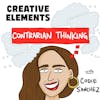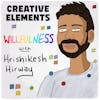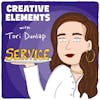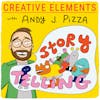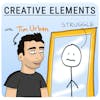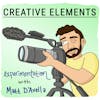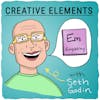
#179: Justin Moore – A step-by-step strategy to get anyone sponsored, regardless of audience size.
Play EpisodeJustin Moore is a sponsorship coach who has closed millions in brand deals.
WATCH
▶️ Watch this episode on YouTube
***
EPISODE DESCRIPTION
Justin Moore is a sponsorship coach who is helping thousands of YouTubers just like you find and negotiate their dream brand deals.
In the last few years, His students have landed over $5,000,000 in sponsorships, and that number is increasing fast. So what's his secret?
In this episode, you'll learn
- The right way to pitch yourself to brands
- How to negotiate without leaving money on the table
- How to handle contracts
- And that you're probably wrong about some things
Full transcript and show notes
Justin's Website / Instagram / YouTube / Twitter / TikTok
***
TIMESTAMPS
(00:00:00) The Man Making YouTubers Millions
(00:01:15) Sponsorship Wheel Overview
(00:05:17) The RIGHT Way to Pitch to Brands
(00:10:46) Who You Need to Pitch to
(00:13:57) Audience Size Doesn’t Matter
(00:19:31) How to Negotiate WITHOUT Leaving Money on the Table
(00:27:15) When the Brand Says NO
(00:31:02) When the Brand Asks for Your Rates
(00:34:56) Nurturing Brand Relationships
(00:37:40) When YOU Should Say No to a Brand Deal
(00:39:53) Creating Unique Offers Based on Brand Objectives
(00:43:30) How to Handle Contracts
(00:46:00) Must Knows About Usage Rights + Exclusivity
(00:52:34) How to Handle Feedback from Brands
(00:55:42) Prioritize Long Term Relationships
(00:57:40) Common Mistakes When Publishing Branded Content
(01:00:20) Analyzing a Brand Campaign
***
CONNECT
🙏 Make a guest or mailbag request
📝 Check out our curated Playlists
***
SPONSORS
💼 View all sponsors and offers
***
SAY THANKS
💜 Leave a review on Apple Podcasts
Learn more about your ad choices. Visit megaphone.fm/adchoices
Justin Moore [00:00:00]:
Do not just spit back one number when the brand says how much for a YouTube integration. If you have a rate card or a rate sheet in your media kit, delete that immediately. Take that page down.
Jay Clouse [00:00:10]:
That's Justin Moore, a sponsorship coach who is helping thousands of YouTubers just like you find and negotiate their dream brand deals. In the last few years, His students have landed over $5,000,000 in sponsorships, and that number is increasing fast. So what's his secret?
Justin Moore [00:00:27]:
My sponsorship wheel is my proven 8 step system, consistent, well paying sponsorships. It's, in essence, a sales It's pipeline.
Jay Clouse [00:00:35]:
Today, you'll learn the right way to pitch yourself to brands.
Justin Moore [00:00:38]:
Most creators convince themself that cold pitching doesn't work because of this. No. It actually does work, but you just have to
Jay Clouse [00:00:44]:
How to negotiate without leaving money on the table?
Justin Moore [00:00:47]:
This is one of the easiest ways to kind of upsell yourself and and make, you know, 5, 10 x more on a deal. Oh.
Jay Clouse [00:00:53]:
How to handle contracts?
Justin Moore [00:00:55]:
If you are checking for these things, once you've received the contract, that's actually too late. Read your contracts.
Jay Clouse [00:01:00]:
And that you're probably wrong about some Publish seems straightforward. Tell me if I'm wrong.
Justin Moore [00:01:05]:
You're a 100% wrong. Okay. A lot of people don't do it right.
Jay Clouse [00:01:13]:
Can you walk me through your sponsorship wheel from an overview standpoint, and then we'll dive in and talk about each piece and how people can use it to land their dream sponsorships.
Justin Moore [00:01:24]:
Alright. So my sponsorship wheel is my proven 8 sepsis and billon consistent well paying sponsorships. It's, in essence, a sales Pipeline. This is a pretty foreign concept, I think, to a lot of creators, but, I've been my my prior life, I guess, was kind of in the professional corporate world. I also ran an agency for many years and had to develop this muscle, essentially, which was how do you take a client from point a, you know, pitching them, essentially, to all the way through closing the deal. And so I I mirrored that process, across to what actually creators should be doing when it comes to, working and closing deals with sponsors and brands. And so the first phase is the pitch phase. Right? And so this is your ability to send a pitch to a brand, To propose a collaboration or to confidently handle a deal when a brand has reached out to you.
Justin Moore [00:02:14]:
So a lot of people think that a pitch is like, oh, you reaching out and pitching a brand, but, no, you actually still have to pitch A brand when they come inbound to you because they you know, it's not the deal's not across the finish line yet. They're probably talking with 10, 15, 20, 50 other creators, and so you still have to convince them that you're the the best person for the job. Step number 2 is the negotiate phase. And so this is the your ability to negotiate Advantageous deal points with a brand or an agency so that you don't leave money on the table. Right? The 3rd phase is the contract Step. Okay? And this is your ability to create or review contracts or delegate it to pros or like a lawyer, for example. Yeah. So every negotiation deal point is accurately represented.
Justin Moore [00:02:53]:
Step number 4 is the concept phase. And this is your ability to review creative briefs and submit concepts to the brand or the agency even if they haven't asked you to. So everyone is on the same page, and we'll get into that further. The 5th step is produce. And so this is your ability to create content that meets or exceeds brands' expectations of timeliness, quality, and or performance. Step 6 is the feedback round, and this is, you know, your ability to remain objective when brands or agencies request revisions or edits or reshoot so that the relationship is actually reinforced and not soured, which is is a little, like, harder than it than it seems. Okay? So step 7 is the publish Around, and this is your ability to publish work accurately and on time without micromanagement by the brand and follow-up with initial data and wins so that your contact looks like a hero. Remember, I ran an, influencer agency for many years, and, yeah, this seems like an easy step.
Justin Moore [00:03:50]:
But, no, a lot of people do not publish things on time, and they're not super responsive. And the final Step is the analysis step, and this is your ability to analyze the overall success of the partnership, tie up all those loose ends, and pitch the brand on the next collaboration.
Jay Clouse [00:04:05]:
This is so good. If I'm honest, I feel like a lot of my processes in the past have been pitch, produce, Publish. Contract is in there a lot of times, but, you know, maybe half of these steps are things that I'm consciously thinking about that I'm intentionally Designing and going through. So
Justin Moore [00:04:24]:
Quick note on aggregate data that I already have. I've had hundreds of creators take this, assessment because I I've turned my sponsorship wheel into an assessment that I call the sponsorship wheel, snapshot, and, it's a free snapshot you can take, and maybe we'll link it in the description. And, essentially, I have data across all of these creators that have taken this. And, without fail, steps 1 and 2 are where people rate themself the lowest. And to your point, the produce step, the feedback, the publish, like, Everyone always rates themself the highest because, like, that's their strong suit. Most creators, like, were publishing content all, you know, every day, you know, all day long, essentially. And so it's just really interesting to see kind of Where because it you know, you essentially get emailed a graphical, spider chart kind of representation of where your score lands. And, yeah, it's the it's the pitching.
Justin Moore [00:05:12]:
It's the negotiating, and it's the analysis Those are the weakest for most people.
Jay Clouse [00:05:15]:
Let's start with pitch, and let's let's assume that the viewer isn't getting many inbound pitches To them yet or as many as they like, and they say, you know what? I am willing to go out and find people to pitch myself to. How do you recommend people go about doing that?
Justin Moore [00:05:33]:
So there's 2 parts of it. There's who you pitch to, who do you actually send this to, and the other part is what do you say. Right? So let's talk about what do you say first. Because if you're sending something that is really uninteresting, then you're it doesn't matter who you send it to. You're gonna get ghosted. Right? So I have a pitching methodology, that's called the ROPE method. That's r o p e. R stands for your pitch has to be relevant to a campaign that the brand is either currently running or has run-in the past.
Justin Moore [00:05:59]:
O stands for organic, meaning that you can tie your pitch back to organic work that you've already published across any of your your platforms. P stands for proof so you can show and illustrate to the brand how you've helped other brands achieve results, And e stands for easy to execute when they say, hey. Yeah. Actually, this sounds interesting. What did you have in mind? Right? And so the the form that most pitches take for you know, when creators reach out, it's like, hi. My name is Jay. I have this awesome YouTube channel. I have all these subscribers, and I get this many views per video.
Justin Moore [00:06:29]:
Here's my demographics. They just kind of, like, Pull open the trench code and, like, you know, bear it all. Right? Do you like it? Yeah. Yeah. Exactly. They're like, please like me. Right? And the brand is just kind of like, woo. Like, no.
Justin Moore [00:06:39]:
Actually, I don't know you, and I'm not cool with with you bearing it all, and they just either delete your email or they don't respond. Right? And and this is the dangerous part actually is that Most creators convince themself that cold pitching doesn't work because of this. Mhmm. They say, oh, man. Whenever I reach out to brand, like, this is not something that's gonna work. Like, no never respond to me. And so it's a it's a really dangerous, thing because, no, it actually does work, but you just have to say something, to to actually, get them interested and excited and wanting to respond to you. Right? And so the big mindset shift in inversion that I hope everyone has is that Your pitch has to be about them.
Justin Moore [00:07:16]:
It's not about you. And so the reason that the rope method is so powerful is that you do a little bit of research. You say, okay. What's going on in the brand's world? It seems like, let's say let's say, you know, we're sitting here, you know, January. Right? We're we're we wanna work with brands, The new year, etcetera. A lot of people think, oh, let me reach out about a new year, new you campaign. Right? Maybe I'm a fitness creator or, you know, I I I'm a, you know, a habit You're YouTuber, and I talk about building habits. Perfect time.
Justin Moore [00:07:43]:
New Year. Right? I'm gonna reach out to this brand. Would love to talk about your brand. And they they say, sorry. No. We're not Actually, doing any paid partnerships right now and the creator's like, what the heck that makes no sense? Well, probably it's because that brand has already allocated all of their budget for Q1 already, which is January, February, March. And so in reality, probably what you need to do is go back and see, well, actually, what campaigns were they running in q two of last year. Mhmm.
Justin Moore [00:08:06]:
Right? So we maybe scroll back on their Instagram. We go back and look at their blog, maybe press releases, see what their marketing, You know, the VP of marketing or influencer marketing manager is talking about on LinkedIn maybe. Right? And you go back and you say, oh, it seems like they were running some this this spring campaign or something. I'm gonna go pitch them and say, hey. I saw that you were running this campaign last March or last, you know, April, whatever it is. Are you gonna be running that campaign again this year? Then you link a post to illustrate that your audience has affinity for this. That's the o in the rope method where it's like, hey. I I, you know, also talk every Spring, I talk about a similar topic about the importance of getting ready for the summer and getting those chiseled abs, right, etcetera, etcetera.
Justin Moore [00:08:48]:
Right? And then the P in the rope method is you say, you know, happy to share some insights of how it helped, you know, this other fitness brand achieve results. And the easy to execute part, this is this is critical, Jay, which is that here is exactly what I'm proposing to do for you. I'm gonna do 2 integrated YouTube videos. I'm gonna give you, you know, the usage rights to take that Content, cut it down into a 32nd ad and run paid advertising with it. I'll give you the rights through the, you know, through, you know, q 2, so end of, you know, June or whatever it is. Are you free on Thursday at 10 AM to talk? That's the rope pitch. It's not, oh, you know, all these, like, big, ambiguous promises or or, you know, you know, things that you say in the email that the brand's just not really gonna get excited about. So you see how how much different that is than just like Yeah.
Justin Moore [00:09:32]:
Hey. I'd love to collaborate with you. Do you wanna wanna chat? You know?
Jay Clouse [00:09:36]:
Yeah. This is so tasty for two reasons. One being, you're talking about getting a quarter ahead of this. Because as you've noted, brands just operate differently than individuals. They often are allocating budgets that were given to them by their boss, The company and these are on a rolling basis. And the other thing that I really wanna underscore, the easiest way to get a yes is to do all of the Heavy lifting for somebody and say, all you need to say is yes or no. And in the previous paradigm where you're just kind of, like, showing people, You know, your media kit and all these properties, you're still putting all of the burden of imagination for the campaign On that individual, it's work. You're handing them work when you're asking them for a partnership and for and for money, ultimately.
Jay Clouse [00:10:26]:
So This rope method is really saying, here's all the hard work. All you have to do is say yes, and I am aware of your Time lines, I don't expect you to say yes tomorrow because I see that sometimes with pitches too where you make a great pitch and say, can we do this next week, next month? And By other constraints, the answer is just no by default.
Justin Moore [00:10:46]:
Yeah. And I'm I'm really glad you brought this up about the the additional work stuff because it segs really nicely into the 2nd aspect of how do you get on their radar. It's like pitching the right person. Let's say that you're trying to target a Smaller brand. When you go on LinkedIn, let's say, and look at the marketing hierarchy of that company, there's probably only 1 person. It's probably the director of marketing. They have 10 people working there or 15 people working there. That person is probably the person that you wanna pitch because they don't really have anyone else.
Justin Moore [00:11:15]:
And so they're doing all the things. They're wearing all the hats. And so the rope pitching method is even more critical in scenarios like that because, again, they they're doing everything. They're doing the, you know, Pay per click ads on Google. They're running their Facebook ads. They're doing everything because they're the they have they have to. Right? And so it changes, however, though, as the organization scale Changes. Right? And so, let's say you're going after a medium sized company.
Justin Moore [00:11:39]:
Now you start to have dedicated roles, and titles called things like influencer marketing manager or partnerships manager depending if it's a b to c, like a business to consumer or b to b, business to business. Maybe it's the digital marketing manager. Maybe it's the content marketing manager. There's all these kind of different titles that you need to start, familiarizing yourself with. But then when you go after some serious scaling, now you're going after the large multinational conglomerate type companies. The important thing to understand is they have now delegated Partnership strategy, paid partnership strategy likely to an agency, a media agency, a PR agency, maybe even a dedicated influencer marketing, agency. And the the real complicated thing to realize is that the largest brands often have multiple agencies Seize now. And so this is one of the things that I learned having you know, when I ran the influencer marketing agency was that there's just these all these kinda myriad paths that you need to kind of Understand and start to, you know, navigate when you start working with brands.
Justin Moore [00:12:37]:
And so, you know, the the complexity definitely changes based on, how many employees work there.
Jay Clouse [00:12:43]:
After a quick break, Justin tells us how to get brand deals even if you don't have a large audience. So stick around. We'll be right back. And now back to my conversation with Justin Moore. If I'm just getting started, let's say that I haven't done many or any Brand partnerships or integrations. Would you recommend that I start with a larger conglomerate and try to find that right person? Or should I start on the lower end Where they have fewer employees, maybe they do just have this director of marketing position.
Justin Moore [00:13:13]:
This is a great opportunity to to talk about something that I call the sponsorship continuum. What you pitch and who you pitch changes based on where you're at in your creator journey. So a lot of creators start out and they're like, I'm gonna go pitch Nike. I'm gonna go pitch Coca Cola. These are my dream Apple. Like, these are my dream sponsorships. And so first of all, gotta do a sanity check here. The the chances of them, you know, working with a smaller kind of nano micro, you know, creator, usually low.
Justin Moore [00:13:41]:
Not impossible. Sometimes they do kind of scale campaigns like that. But it may be more realistic to set your sights on the smaller to medium sized companies in the beginning. But what I like to talk about when it comes to the continuum is you you think about These kind of 3 moments in time. So when you're starting out and you don't have much experience or you don't have a a super large audience and you don't have a lot of influence, If you were were to reach out and pitch a brand and say, hey, let me talk about you on my YouTube channel. That's likely not gonna move the needle for them. Right? And so they're probably not gonna respond to that. However, if the thrust of your pitch is, hey, Brand.
Justin Moore [00:14:15]:
I did an audit of your social presence. Right? I looked across all your social channels. I looked at your blog. I looked. I saw that you didn't, you know, have these kind of content pillars in place. I would love to help create some content for you that you can utilize On your, what's called o and o, your owned and operated, you know, sites or maybe third party ecommerce platforms like Amazon or maybe use it for paid advertising or something. Heck. Maybe I can do some consulting for you.
Justin Moore [00:14:40]:
And in this scenario, your YouTube channel or your platforms are your portfolio. Mhmm. And so it's just and a lot of people don't think that this is a sponsorship, but it absolutely is because you're leaning on your credibility having grown the Channel to help the brand in in kind of some other interesting ways. And so that's the first part of the continuum. Then you move a little bit. You grow. Right? Maybe you're getting Thousands of views per video now. Right? And so now maybe when you reach out, it's a combination.
Justin Moore [00:15:08]:
It's a combo of consulting. Maybe you're gonna create some content for the brand, use, and, yeah, maybe now posting natively on your platforms maybe becomes part of the deal, becomes meaningful to them. Now let's move to the 3rd pillar of the continuum, which is, okay, you've achieved some scale now. You're getting tens of thousands of views or listens or opens, whatever your platform is. And now maybe it is incredibly meaningful for you to create and post natively exclusively natively on your platforms, and you're not doing, anything for the brand on their platforms. And so I really like this continuum to help kind of, you know, navigate where am I at in the journey, what types of brands should I pitch, And what's the highest probability of me actually closing this deal?
Jay Clouse [00:15:46]:
You're kind of debunking this myth that I hear from creators a lot, which is they think there's this Threshold of my audience being big enough to do these sponsorship deals. And maybe there are thresholds in the minds of Some employees at some companies, but a lot of creators limit themselves because they think I need to have 10,000 subscribers or 10,000 followers. But it sounds like you're suggesting audience size doesn't matter. You just change what it is that you're pitching in terms of the deliverables of The partnership.
Justin Moore [00:16:17]:
I'll be totally real. Like, there are absolutely brands who care about the vanity metrics. Like, some of y'all watching this or listening may have Experience this where a brand reaches out, oh, you need this many minimum views on average for for us to work with you or, yeah, certain number of minimum followers or Scribe or reserve or so it happens. There are definitely ignorant brands, in my opinion, ignorant brands who don't understand that subscriber ship, those a lot of those vanity metrics Irrelevant. Like, what really what really matters is the influence. Right? Like, what are you able to drive the results, for what the brand is trying to accomplish? And so I'll be yes. I ran an agency. I I've dealt with those clients.
Justin Moore [00:16:52]:
It's frustrating. It happens. But what I hope you hear is that there exist brands out there Who are savvier, are smarter. But also you may actually need to educate them. Right? A lot of what I talk about is, like, Actually, it's your job as a creator to educate them about what's more important when it comes to doing an activation and and doing a collaboration with a creator. And a lot of people, I don't wanna do that. It takes Too much work and okay. It's fine, but I can't tell you how many creators I've worked with and coached and all this stuff where it's like they put in the work.
Justin Moore [00:17:22]:
Oftentimes, it's in a Traditional industry more of a kind of a traditional industry where brands aren't used to compensating creators in that way. And so, yeah, sometimes it can be a slog. 6, 12, 18 months Where they're having lots of Zoom calls and lots of emails, and it seems like you're running up against a brick wall, and then you finally break through. I can share a quick anecdote and Story of a creator that I worked with who is in the, scuba industry. His name's Thomas. His channel YouTube channel is called Circle h Scuba. And when we first, had our initial coaching session. He was running up against this wall on peep you know, brands.
Justin Moore [00:17:53]:
They just they're used to giving free gear, free product. Right? They just are not willing to compensate or pay anyone, and so he just started on this path educating, going to these industry trade conventions, Talking with brands, kind of helping them understand the value of working with brands. And now he's finally broken through, and he has this you know, he got his first Very lucrative paid, brand partnership recently. He mentioned it, covered his the way he put it was it covered his mortgage payment. It was it was more than a mortgage payment, Less than the, MSRP of a test Tesla. Those are his words. And so these these really exciting things are happening to him because he put in the work.
Jay Clouse [00:18:29]:
Okay. So let me recap a little bit. It sounds like you recommend using LinkedIn to find, like, the company page, probably look at who are the employees in this company, try to find the specific titles of marketing or partner manager influencer manager send them a pitch written in the rope method at the end of that the e part of that easy to Easy to implement. You have a specific idea for what the deliverables could be. What happens next? What happens when the brand responds? How does the conversation continue and what should I be trying to do as the creator?
Justin Moore [00:19:01]:
Well, now it's time to negotiate. Right. You know, a lot of creators think that That they're just so lucky to have gotten the brand interested. And so any number that the brand throws out, Well, this is how much we can pay you. They just say, oh, okay. They they, you know, they just they trip over themselves to say yes, and they don't wanna counter, you know, negotiate or counter offer anything else, whether it's the deliverables or the pricing or whatever it is, because they're afraid that the brand is gonna walk away. And I and I get that. I understand.
Justin Moore [00:19:30]:
Partially, I understand. I I get it because it's almost like validation. That first those first couple paid partnerships that you do when a brand gives you the time of day And it's offering to actually pay you money. It almost is kind of a you're able you feel as though you can kinda give the middle finger to all these people in your life who doubted you. It's like, see? Yeah. You all didn't believe on believe in me. Like, look at this. This is a a brand willing to pay me for this, you know, content that I'm creating on the Internet.
Justin Moore [00:19:56]:
That's a transformative moment. And so I understand that, like, it's a it's a hard thing for me to tell people like, hey. Like, calm down now. Don't just accept the 1st deal. And so, you know, I'll never fault anyone for taking the you know, that First number that they throw out. But once you get a few deals under your belt and start to realize, you know what? Actually, I think I left a lot of money on the table, or I think I actually, You know, came out with the short end of the stick here. You know, $50 plus a free bag of potato chips actually maybe isn't the best deal. You know? This type of thing.
Justin Moore [00:20:23]:
Right? And so I think the first thing is acknowledging that, you actually have a lot that you're bringing to the table as a creator. I kinda like to think of, you know, creators as production companies in a box. Right? You are the creative team. You ideate all of the ideas. Right? You're the production team. You do it all. You're often the editing team. Right? You are often the marketing team, and you have an organic distribution channel.
Justin Moore [00:20:47]:
If the brand didn't hire you, they would have to go out there and hire a production company, Actors and actresses to star in this content. They'd have to hire an editing team to cut the content. And when they have that Finalized piece of content. They now have to pay YouTube and Instagram and Facebook to run that ad. You can do all that yourself. Right? And so the next time that you are feeling gun shy to send back a counter, you know, offer to them a different number, Just remember that you have the power.
Jay Clouse [00:21:21]:
I love laying out all the different cost drivers that a brand would have If their alternative was doing it in house versus working with somebody like you who can create the the asset and who potentially has An audience distribution for that asset that's so good to help people realize the value that they're offering. Yep. When I send this pitch, even if I do have the idea for the deliverable, the e part of the rope method, I assume A lot of times, timing is wrong or maybe that specific package isn't right and the brand responds like, this isn't quite right, but let's talk on the phone how do I handle that conversation and come out with a new idea for What to offer to to start the negotiation.
Justin Moore [00:22:08]:
The first thing I'll say is it's almost certain that the brand is gonna say, we don't wanna do that exact thing you're pitching. Because the point Of the pitch is not to get them to say yes right away. The likelihood of them actually green lighting it. Okay. Yeah. Here's the money. Do that exact thing you pitched me. No.
Justin Moore [00:22:29]:
It's giving them something tangible that they can react to.
Jay Clouse [00:22:33]:
It also makes you look professional. It it shows, like, I am somebody to be taken seriously.
Justin Moore [00:22:38]:
100%. It makes you look professional. And, again, going back to the whole idea of, like, don't make them do any work. Now they don't have to think, oh, like, how could I create this greater? They don't know. They don't know who you are. It's you actually pitching what you believe is is your strength and them saying, well, you know what? That's interesting. I like your initiative here, but that's not our focus right now. Let's Talk about this other perhaps initiative that we're working on next quarter.
Justin Moore [00:23:00]:
And so, you know, this is a really important insight, which is that the point of a pitch is not to get the deal. The point of a pitch is to get on their radar so that the next time they have an opportunity that slides across their desk, they're gonna think That creator that reached out to me is a perfect fit. And it's not just about reaching out that first time. It's about nurturing that relationship for a long time. So if they, You know? Just expect that they're gonna when you pitch them, they're gonna say, hey. We don't have any budgets for any, you know, paid part let me let me pull back the curtain, Jay. Okay? I ran an agency for many years, and this is how it happens. Let's say you reach out and you pitch a brand cold on random May 4th, whatever.
Justin Moore [00:23:37]:
Right? What you didn't realize was that the brand just wrapped Recruitment for their summer campaign on May 1st. You're 3 days late, but there's no way that you could have known that. And so what happens? The creator looks at themself. It's the long dark night of the soul. They look at themself in the mirror and they think, I suck. Play a violin right here, by the way. I suck. The brand hates me.
Justin Moore [00:23:58]:
My pitch sucked. No one's ever gonna wanna work with me, and this is what happens is that you turn inward. Right? And I get it. I totally understand that, especially in the absence of of them telling you that. Right? Because a lot of brands won't. Right? And what you absolutely cannot give up here because what happens? On, you know, middle of May now or late May, k. The brand is going to have an all hand you know, an executive team meeting where the CEO is gonna ask the marketing team, Hey. How much money did we allocate for the summer campaign to TikTok or to YouTube or something like that? And the marketing team's gonna look at themselves and be like, crap.
Justin Moore [00:24:31]:
We don't have a YouTube strategy or we don't have a TikTok strategy or whatever. And realize that in order to appease their executive team, they have to get their act and figure out what to do. But, again, the summer campaign's already fully baked. They already recruited the the people. They can't do anything about it. Right? And so campaign starts happening. Okay. Great.
Justin Moore [00:24:47]:
Now, you know, here's what you do. You parachute into their inbox on random June, you know, 4th, whatever, and you said, hey. Saw this, You know, article on Adweek or Digiday about how other brands are are, you know, in your industry are killing it with, you know, long form YouTube content or short form whatever. Thought your team might enjoy this. Right? And so, again, oh, they remember who you are. Right? You provide value. They call an internal meeting to talk about this article that you sent. Oh, interesting.
Justin Moore [00:25:13]:
Okay. Again, Providing value. Now they you'll fast forward to end of July or, you know, middle of, August. Okay. Now we're gonna have an all hands meeting about The results of the summer campaign. Interesting. Okay? Now the, they're gonna talk about, okay. Here's how it went, and here's Why we need to allocate an additional 100 k or 500 k to long form video content or short form content for the fall campaign? And, again, here you come back in their inbox with some other value in article or an offer to chat with their team, whatever.
Justin Moore [00:25:46]:
And so now Fast forward. Here we are. End of, you know, back to school time, whatever. Finally, the CFO green lights that incremental budget for That fall or maybe even, holiday or wood or winter campaign. And so the the what I and and so but surprise, surprise. Who do you think they're gonna reach out to about that campaign? You think it's gonna be that creator that gave up Way back at the beginning when the brand said, oh, sorry. We we're not recruiting anymore. No.
Justin Moore [00:26:08]:
They're gonna reach out to you because you were at the forefront of their mind for 4 months providing value.
Jay Clouse [00:26:14]:
Talk to me about these parachute emails that you're sending in this during this period of time. Because a lot of times, the timing's bad. Brand says, hey. Sorry. Timing isn't good. We take that as rejection. We think that We that partnership is never going to happen. Sounds like you take that as a first step.
Jay Clouse [00:26:29]:
As you said, the the goal of the pitch is to get on their radar. So how do I continue the relationship in a way that warrants a response from them, but Isn't you just saying, like, hey, do you have money now?
Justin Moore [00:26:44]:
Do you have
Jay Clouse [00:26:44]:
money now? Do you have budget now? Like, what's what's what what is that conversation like?
Justin Moore [00:26:47]:
There's this great visual. It's this Minor underground. He has a pickaxe. Okay? There's 2 minors. At the very end of the, graphic is Riches. Right? We've got diamonds. We've got cash. We've got, you know, a treasure.
Justin Moore [00:27:01]:
Right? The the miner on the bottom is faced the other direction. He there was a sliver Of ground in between him and the the goal, and he gave up at the very last minute and is kind of dejectedly walking back towards the beginning. And it's the miner on the top who is just continuing to chisel away, realizing that on the other end of a bunch of hard work, Guaranteed is going to be riches. Guaranteed is going to be, you know, that that treasure. If you look at it on a per brand basis, yes, Of course, there are gonna be some deals that don't pan out and some brands who just, you know, kinda put their hand up and aren't going to. But if you look at it, The strategy as a whole. And look at it as I as long as I keep persevering, as long as I keep providing value. And there's various different things that you can say in these email.
Justin Moore [00:27:52]:
Know, we talked about the articles that can help. You know? Something I've done a ton is like lunch and learns. Hey. Let's get on a Zoom call. You can call, you know, everyone from your agency or everyone on your brand, and we can talk about what I'm seeing on the ground as a YouTuber or what I'm seeing on the ground as a TikToker. They'll eat that stuff up. Like, they don't they don't get a number 1, they don't get a chance to talk with creators in that way because a lot of creators don't wanna give them the time of day to get on a phone call like that. Right? And so if you're the person Out there at the forefront educating them, you know, helping them understand how to cut through not only with their partnership strategy, but with their own content strategy.
Justin Moore [00:28:25]:
Because, remember, Brands are posting stuff on the Internet too. It's not just collaborating. Collaborations with you. Right? And so if there is, like, nuggets that they can learn from you, that's really valuable. And so there's My whole thing is, like, it's this concept of pivoting. If they say no to you, you don't accept no for an answer. You say, okay. You didn't want that? Fine.
Justin Moore [00:28:41]:
Let me pitch you something else, or Or let me propose this other thing to you over here. Oh, how about a seasonal, you know, idea? You didn't wanna do a a, you know, a holiday thing? How about new year, new you? Oh, you don't wanna do new year, new you? How about spring? Know, this type of it is like you never you can never give up unless they say, don't ever contact us again. Of course, don't contact them. But, like, most brands are not gonna do that. I a a story here, from, a a co a client of mine, a coaching client. Her name is Emma. She runs a cruising YouTube channel, And she shared in our private community, recently that, she finally it was like, we have a share your win section of our community. And she said it took 4 Emails of pitching this one particular brand without hearing back from them until she finally got a response.
Justin Moore [00:29:24]:
And they said, oh, I'm so sorry. You know, it's just been crazy on our end. Yeah. Let's work together. And now they're moving forward on a deal. So could you have the tenacity, Everyone listening here, could you have the tenacity to email a brand 4 times without hearing back from them? Like, could that be a goal that you set for yourself and realize that, You know, it's not no. It's just not yet.
Jay Clouse [00:29:44]:
Yeah. I think about this sometimes. I mean, this is true in in different professions too. Like, if you're pitching an investor, These people, part of their job is allocating funds. You're not imposing by giving them an opportunity that is part of what they're doing in their day to day job anyway. So I love this this tip of being tenacious. One one response that I've gotten in the past is, hey, it's not a good fit right now, but can you send your rate? Can you send your rates for a typical video? And I hate doing that I hate reducing what I can do to a typical rate card that I send to Brand x and brand y who might be 3 times the size of brand x. So how do you handle that response of, hey.
Jay Clouse [00:30:25]:
Can you send your rate card?
Justin Moore [00:30:26]:
A 100% acknowledge this happens sometimes, and your response should be essentially, every deal I do is bespoke. I do not have standard rates because my what I propose to you, brand x, is going to be customized based on your objectives. And this is a great opportunity to talk about how important it is if you have a rate card or a rate sheet in your media kit or you have numbers or a place that You send people on your website, oh, yeah. Just go book a spot, you know, on my YouTube channel or newsletter or whatever, delete that immediately. Take that page down. If you're trying to price yourself in a vacuum, Jay, where all the only thing that you're using to, like, kinda, you know, calculate your worth is your own metrics. You are completely leaving out the other 50%, which is the brand's objectives. And so A brand will have 1 of 3.
Justin Moore [00:31:15]:
A 100% of the time, they will have 1 of 3 objectives. I call it my ARC framework, ARC. A is awareness. So it's a new product launch or they're launching in a new territory. They were in the UK, now they're launching in the US. Okay? So they want to, You know, top of funnel. They're trying to get as many eyeballs on this thing. Okay? R is repurposing.
Justin Moore [00:31:35]:
So the primary reason that the brand wants to collaborate with you is to Take your content that you create and repost it on their social platforms, embed it on their website, maybe run paid advertising with it. And the final is the c is conversions. And so this is where the brand yeah. They wanna drive sales. They want to, you know, generate App downloads, they wanna get trial signups for their software program. The reason that it's so critical that you understand what success looks like to this brand is that your pricing has to change. A lot of creators think that the only thing brands care about is conversion because some some will say that, oh, yeah, sales. That's that's what we care about.
Justin Moore [00:32:11]:
But, again, going back to this education piece, A lot of brands don't really understand the difference between these 3 things. Let me give you a quick example of why this is so critical that you ask them about their objectives is that, Let's say that you say, hey. What would success look like to you? What is a win for you if we were to partner? They say, oh, well, you know, we we just love the way in which you create video content. It's Super compelling. And the main reason that we wanna work with you is we want to, you know, run you know, take a a 32nd cut down of the YouTube video that you post and run ads with it. In your mind, you should be like, they just told me that they don't really care that this is going live on my YouTube channel. What they really wanna do is run ads with it. So Instead of saying, here's my rate for 1 integrated or 1 dedicated YouTube video, you say, hey, you know what? Knowing that that's your goal, I could actually create five 32nd videos that you can run as ads and I'll vary up the hook.
Justin Moore [00:33:04]:
I'll vary maybe the key messages. I'll have different calls to action at the end. You can just throw the throw that in the meta, you know, Facebook, Instagram black box, see which one does better. Since that's what you said, how about we do that instead? And I won't even post it on my YouTube channel. Yeah. It's gonna be 5 x, you know, the investment. And you know what the beautiful thing about that scenario, Jay, is that now the amount that you can charge is completely detached from your subscriber ship or your viewership.
Jay Clouse [00:33:29]:
Totally love that. And a lot of times, especially with YouTubers, I find, they they get really uncomfortable about making, like, a Dedicated video for the sponsor, and they don't realize that maybe what the sponsor wants is just content of a user, somebody who loves the Product talking about it, they can put on their own channels. It doesn't need to be a dedicated video to your subscribers. It could be this repurposing, objective. When does when does this conversation happen? How does this conversation happen to figure out the brand's objectives?
Justin Moore [00:33:59]:
I mean, this should be the very first question you ask them, whether it's in an inbound, You know, email inquiry or, you know, preferably getting on a phone call with the brand. And I know a lot of creators are like, I don't know if I wanna get on a phone call with a brand. That terrifies me. You know? If I told you that establishing that initial rapport could be the difference maker, to differentiate you from the 50 other creators that they're speaking with, Would you do it? Because this is what happens is that remember, I ran an agency for many years, and the creators who were willing to just kinda get on a phone call with us, kinda Maybe it was a a campaign where the brand wanted some creative ideas from some of the potential partners before kind of green lighting the whole thing. If you were the creator who was willing to jump on a 10, 15 minute phone call with us, even if you ultimately quoted us, our agency, to three x, What these other creators, you know, were charging, we might just go with you because it seems like the campaign is gonna go better. Right? Because we could put a face to a name. We It seems like you're serious. You're professional as we've talked about.
Justin Moore [00:34:58]:
You know? And so don't discount the value of just sucking it up, you know, just Figuring out, dig deep and find that confidence to kinda get on a phone call. And you just ask them literally, what would success look like? What would a win look like? And the other reason why it's so critical is that if the brand can't tell you, that's a red flag because you're setting yourself up for failure. If they can't tell you, like, You know? Here's here's what success would look like. This many sales or just this many impressions or views or just more brand awareness or whatever, they can't tell you that, then there's no way that you're gonna win. Because if anyone has ever happened had this happen where, you know, a brand reaches out, they say, how much for a YouTube video? You quote them a number. You know? You do the deal. You post it, and then the brand comes back and they said, hey. It didn't generate sales or it didn't generate this.
Justin Moore [00:35:44]:
And you're like you throw your hands up, and you're like, well, you didn't tell me. That was, like, You know, the goal if if that was your goal, I would have recommended you do this thing over here because that would have moved the needle, you know, more meaningfully. Fully. And so, again, you have to the onus is on you to be asking these questions as a creator.
Jay Clouse [00:35:59]:
Something that's probably worth reminding people is Brands run on people. Like, you're having conversations with real people who have jobs who want to enjoy They're day to day. So, like, if you are a pleasant person to work with, that's gonna carry some weight in their mind when, Ultimately, they're just doing their jobs. So like you're saying, getting on the phone, having these conversations, adding value, There's, like, this 4th unstated goal beyond awareness repurposed conversions, which is I just wanna, like, enjoy what I'm doing. And if you could be somebody that's, like, their favorite partner to work with, Probably gives you some pricing leverage as well.
Justin Moore [00:36:37]:
Mhmm. 100%.
Jay Clouse [00:36:38]:
When we come back, Justin teaches us how to charge more for every brand deal we pitch. You won't wanna miss this, so don't go anywhere. We'll be right back. And now please enjoy the rest of my conversation with Justin Moore. If I ask the brand what their goals are and they don't know, do I I mean, obviously, I I try to help them arrive at it in that conversation. But if they genuinely don't know and they have to, like, ask their boss, Do I forego the campaign because I don't see a way to win?
Justin Moore [00:37:06]:
100%. Don't do the deal. You can't do the deal if they don't know what's you're you're setting yourself up for failure. Hopefully, you're able to have these conversations and try to ascertain or maybe help them through. You know, this this happens a lot where you may be talking with a brand who's never done An influencer marketing campaign, or maybe they just they've only dabbled in it. And so, again, like, they don't they don't know the different they you'll ask them what success is, and they say awareness and conversions. You're like, hold on a second here. Like, we're talking about very top of funnel and the very bottom of funnel here.
Justin Moore [00:37:35]:
That's not you know, I can't accomplish that in a single YouTube integration. Right? So you now is the time to educate them. Okay. Well, if that's the case, we should probably do multiple videos. Some will be focused on that top of funnel because because, again, the way in which you tactically execute, That integration will change, Jay, because an awareness campaign is maybe you say maybe Maybe it's a a video podcast you're doing on YouTube. You say, this video this podcast is powered by or supported by brand x. And there's no other mention of it. Maybe throughout the entire episode, you may not even link them in the show notes because that's an awareness goal.
Justin Moore [00:38:17]:
Maybe there's, like, a a little, you know, badge on your podcast cover art that says powered by brand. That is an awareness play. A conversion play is Click the link in the description box and, you know, use creator wizard 20 for 20% off your 1st purchase. That is a bottom of funnel direct response Conversion play. Again, the way in which you tactically execute it is going to change based on their goal. And so you have to educate yourself as a creator about the difference.
Jay Clouse [00:38:41]:
You're so good at this. And this is something that we talked about on on your podcast where you helped me with my sponsorship strategy, which has helped me a lot because We work with some of the same partners, and I know well, 1, I can see that you're going about the partnership much different than I am, and I know that you're probably Capturing more value and probably creating more value. Certainly creating more value than than I am at times. And it's because you do this step of Learning about the goals, creating a bespoke package. So that's what I wanna talk about next is how do I create these bespoke packages of deliverables? Once I've talked to the brand, they've told me their priorities, they've told me their goals, what's the next step for me to get this thing moving forward?
Justin Moore [00:39:18]:
Let's start with the basics, which is, okay, moving from here on out, everyone watching or listening, do not just spit back one number when the brand says how much for a YouTube integration. Okay? Don't do that anymore. Okay? Because you're leaving a lot of money on the table. Okay? And so from here forward, we're always going to offer multiple packages even if the brand is not asking for them. Okay? You're not limited by what the brand is asking for. Okay? Just give you give yourself that permission. Okay? It's very it's very liberating for a lot of people to think, oh, wow. I could actually, even though they're asking for 1 YouTube video, yeah, you could pitch them 5 YouTube videos.
Justin Moore [00:39:47]:
You could do that. It's okay. Right? And and the reason that you do that, by the way, Jay, let's go back to first principles here, is because, again, They're probably talking with lots of different creators, not just you. And so if you help them understand, oh, actually, we could just do 1 contract with this 1 creator. They could they could do 5 times the amount of work. It's less email threads, less back and forth. Sure. You have now just basically stolen or borrowed budget from all those other, you know, Other creators that they were gonna potentially work with.
Justin Moore [00:40:13]:
And so this is one of the easiest ways to kind of upsell yourself and and make, you know, 5, 10 x more on a deal. But it's not just about quantity of work because a lot of people think, okay, packages. Sure. Let me do 5 packages, and I'll just, like, Linearly increase the amount of deliverables in 1 video. 2 videos. 1 video. 3 videos. Yeah.
Justin Moore [00:40:31]:
4. 5 videos. And maybe, yeah, and maybe The only incentive for the brands to pick that higher tier is, like, a price concession, like a discount or something. Right? A lot of brands are just not gonna pick that. Right? And so instead, the real, eye opening, change is you have to tie the brand's goals to what you propose in each tier. So there's different tactics to help them meet their goals. And so, you talk with them on that phone call or in the email thread or whatever, and they give you a couple different Oftentimes, they will. They say, okay.
Justin Moore [00:41:02]:
Driving more leads to, you know, x, y, z, or, yeah, maybe sales is one of the goals, or maybe, you know, getting some great content is another goal. And they're they're gonna tell you a couple different probably. And so you say, okay. Great. For goal 1, which is getting great content, that's gonna be package 1. That's where I I create some assets for you that I don't even post. You can repurpose those in various different ways, x, y, z. That's that's price x.
Justin Moore [00:41:24]:
Okay? Package 2 is now gonna be completely different then package 1, because it's gonna be tied to goal 2. Goal 2 is, let's say, conversion focus. Okay. That's where I'm gonna do the newsletter blast, Or that's when I'm gonna post on my community tab on YouTube, and, you know, I'm gonna give people a promo code or whatever. Right? Because it's we're trying to drive this that's a direct response type Advertising approach. Right? And then package 3, yeah, maybe that one is gonna be the awareness play, and that's where you're gonna be the 12 month exclusive sponsor of Podcast or the YouTube channel or every video I do or whatever. And so what do you think is the big learning lesson here, Jay, is that the Only way for the brand to accomplish all their goals is to pick the top package, which includes everything.
Jay Clouse [00:42:04]:
So good. It's like It's like sponsorship juju jujitsu. Say, if they're gonna if they're gonna ask for multiple goals, it's like, alright. But
Justin Moore [00:42:13]:
Yeah. I I I'm I'm I'm I'm embarrassing myself because I actually don't know the difference between karate and jiu jitsu. I just goes kinda good doing this type of
Jay Clouse [00:42:19]:
thing. Okay. Let's let's fast forward a little bit. I am woefully underperforming all of the areas of trying to hit the sponsorship wheel, but I wanna hit a couple more high points. We've got the packages. Brand says, I want package 2 or I want the top level. Let's talk about the contract. Am I sending the contract? Is the brand sending the contract? Who takes a lead there?
Justin Moore [00:42:40]:
I would say rule of thumb, the larger a brand gets, almost in all circumstances, they're going to have a Boilerplate contract template that has been blessed by their legal team that they're gonna wanna send to you. The smaller a brand, is they'll they may not have a contract, you know, for you to say. And so they'll either say, oh, it's okay. We'll just use this email thread as proof or this DM exchange as proof. Definitely not okay. Or they're gonna say, can you send the contract? And a lot of creators are, like, you know, they clam up because they don't have 1 or they don't know what to do. Right? Again, going back to this whole professionalism thing, one of my biggest pieces of advice is go out and hire a lawyer for a couple hours, Ask them to create a boilerplate contract template for you where the only thing that you change on a deal by deal basis is The appendix, which is essentially the the very last page. It's it include and it includes everything about the the deal dynamics.
Justin Moore [00:43:33]:
Right? You've got the SOW, which is the statement of work, kind of the deliverables. You've got the usage rights. You've got the exclusivity. And all of the other, you know, doc you know, you know, terms in the in the, you know, Beginning of the document are kind of all the stuff to protect you. Right? The limitation of liability to make sure that, you know, there's no perpetual rights that the brand is receiving to your content, etcetera, etcetera. And so lot of people say, like, oh, well, you know, I don't have the money to go out and hire a lawyer to do that. And and so here here's where I sit you down. I'm gonna be your tough love Sponsorship coach here, your mentor, and say, look.
Justin Moore [00:44:04]:
If you're starting any other business, there is a cost required for you to start that business. Let's say you're creating an ice cream shop. Okay? What do you have to do? You have to hire labor. You have to hire equipment. You have to get insurance. You have to probably pay for that brick and mortar location with rent or a lease or whatever. Right? That is a cost to actually run that business. And so as a creator, what are your costs? Camera equipment, Software, computer equipment, whatever.
Justin Moore [00:44:27]:
And if you're doing partnerships with brands, probably hiring a lawyer to create a contract template for you is a worthwhile investment. Don't just be and don't just say, oh, I'm not gonna do this until I have a deal in hand that will pay for for the for that. And and because a lot of people, oh, well, my deal's $500, $1,000 if I do if I hire or lure, I'm gonna eat up all my profit. It's like, no. This This has to come first. Okay? If you're serious about this as a creator, this is something you should do.
Jay Clouse [00:44:51]:
And maybe it will eat up all your profit on this deal, and then you have it for the future. Exactly. On this deal. You mentioned a couple of key points there if I'm creating my own contract. I think you said deliverables. You got a couple more things. If I'm adding those to my contract first of all, can you repeat those those important aspects? I think it's 3 of them.
Justin Moore [00:45:11]:
Yeah. There's the, so I call it the due rule, which is d u e, the deliverables, the usage rights, and the exclusivity. Those are kind of the main buckets that you need to consider, when when you're kind of scoping a deal.
Jay Clouse [00:45:23]:
And what does what does that look like? We haven't talked about, we've talked about deliverables. We haven't talked about usage rights or exclusivity. How does that play into these deals? Because maybe it is Part of the negotiation up front, but it sounds like it's definitely a part of the contract phase here.
Justin Moore [00:45:35]:
You know, we talked about you know, sometimes the brand, You know, the chief thing that they care about is is using this content in in other ways. I have a quick story here. In the day when my wife and I, you know, first started our our YouTube channel when she start, started on in 2009, she was tickled to get any free stuff. Right? And, you know, when a brand offered to, like, pay her, that was like, woah. This is crazy. Right? That was kind of the early days for us. There was this deal that we did Where, we had worked with this brand, a clothing brand, several times, but they weren't compensating, my wife, April. They were paying her in Site credit or, like, kinda clothing credit.
Justin Moore [00:46:11]:
Right? It was a kind of a major, fashion retailer. Again, this was I think she was getting, at that time, maybe, like, $1,000 worth of credit, which was awesome to her. You know, $2,000, this type of thing. What we didn't realize, though, is that the agreement that they sent to us, clarifying that we know we were gonna get the 1,000, $2,000 worth of clothing credit, We signed away the rights, the usage rights, for broadcast TV. And so one day, we turned on the TV. We're just, like, watching TV, and there, There goes April's face, her her YouTube videos. They just took a, you know, cut of that YouTube video and put it into a broadcast TV commercial, and that thing ran for years. And the compensation that we got from that was $2,000 worth of clothing credit.
Justin Moore [00:46:53]:
And, again, like, the the a lot of what I I'm talking about today and a lot of what I've learned over the years, having been a creator myself for many years, but also running the agency is this type of thing. It's the it's the hard earned mistakes that we made along the way, which which I'm trying to, like, help people realize. And so that's this is why usage rights is so important. It's not just letting the brands embed it on their website or put it on their Instagram or something. It could be something as significant as broadcast TV or out of home, like a billboard or a bus bench or a print magazine or something like that. And so there's 2 different types of usage rights. You've got the organic usage rights, which is allowing the brand to just natively repost the content on, you know, their site, their social, etcetera, or paid usage rights where not only are gonna they're gonna, you know, post it there, but they're going to put additional dollars to amplify it to Mhmm. A lot of people, not just your audience.
Justin Moore [00:47:41]:
And so that that second bucket, which is the paid usage rights, they absolutely should be paying you for that privilege because they're using your name and likeness, to essentially, you know, rub off on their brand. It's it's essentially a very, very loud Testimonial for them. Right? And the exclusivity is also very critical because the brand is oftentimes telling you it's it's sometimes called competitive protection But they're saying, hey. You cannot work with our competitors in a certain category for a certain time period. Right? So they may say, yeah, you can't, you know, work with, You know? Let's say it's a consumer electronic. Actually, I have a story here. I I a creator that I worked with early on coaching, she did a deal with a mattress company. Okay? You know, these, like, Casper and, you know, you know, Lowell and a lot of these large mattress brands.
Justin Moore [00:48:26]:
And so the deal was for a free mattress. She wasn't compensated. Okay? And the deal that she signed was exclusivity for 5 years. Oh. For a free mattress. And so let's say one of these other larger, you know, mattress brands came to her in four and a half years And was gonna pay her a you know, had a big bag with a money sign on it and say, hey. Let's collaborate. Oh, sorry.
Justin Moore [00:48:54]:
Can't do it. So so Read your contracts. Moral of the story.
Jay Clouse [00:48:59]:
Yeah. So when you create your own contract, if you're sending it, you can write your own terms here. But if you're getting the boilerplate contract, which is usually longer, it's more intense, it's usually more restrictive, I would guess. It sounds like you are looking Specifically, things related to usage rights, exclusivity, and you're saying, am I being paid for that? If not, Let's remove it. If you wanna keep it, pay me more for it. It sounds like, the conversation that you're having when you when you get these contracts.
Justin Moore [00:49:28]:
So let we actually have to take a step back here, which is that if you are checking for these things once you've received the contract, that's actually too late. You need to be ascertaining these deal dynamics at the very beginning of your negotiation with the brand. Because the moment that you have a written contract in your hand, your contact has told all of their superiors and the legal team that you are good to go. And so if you're catching something at the contract stage and coming back and be like, you need to pay me more money, that contact Now has egg on their face. They have to go back to their boss or to their client if it's an agency or the legal team and be like, hey. I know I told you that Jay was locked in, but now he's demanding more money. And it's it introduces all this friction, and it kind of sours the relationship because it makes you seem greedy to to some degree. Right? And so it's your job.
Justin Moore [00:50:18]:
The onus is on you to actually catch this stuff earlier.
Jay Clouse [00:50:20]:
And when you're ascertaining this early on in the conversation, sometimes we think about contracts it starts to feel like a combative negative conversation like a battle oh I win you lose but I would guess there's a lot that you can convey in like your tone and inflection when you're talking you're not like hey No exclusivity. Right? It's more like, let's talk about exclusivity.
Justin Moore [00:50:44]:
Yeah. Yeah.
Jay Clouse [00:50:46]:
Like, making it more of a conversation where you're, like Yeah. Agreeing on something and not, like, Like, fighting.
Justin Moore [00:50:52]:
Exactly. It's like, again, going back to it's it's just a bunch of questions. It's a series of questions. You know? What are you looking to what platforms are you looking to activate? Because a lot of brands will come inbound, and we'd love to collaborate. They don't have a scope of work. They're just, like, we would love to collaborate. Like, let's talk about that. Right? And so Your job is to come back with a list of questions.
Justin Moore [00:51:08]:
Whether it's on the phone call or over email, you say, you ask about the deliverables. You ask, are you good you know, looking to, you know, use this for paid media? Are you looking for exclusivity? It's these questions that you ask every time to scope video, and a lot of creators be like, well, well, that sounds like it's gonna scare some of the brands off. And my response to that is Good. Good. It should scare some brands off because you don't wanna be wasting your times with time with brands who don't understand the importance of these types of of aspects.
Jay Clouse [00:51:32]:
I wanna fast forward through the concept and produce phases a little bit because I'm gonna trust the viewers to do a decent job of of that and you'll get better over time the step of feedback before publish in your sponsorship wheel I can see creators getting frustrated there with, like, hey, I made this thing. I put a ton of time into it. What do you think brand? Brand might come back and say, can you change these Things not realizing how much effort it would go into to changing those things. So how do you recommend people handle this feedback period before the integration goes live?
Justin Moore [00:52:06]:
So I know you wanna gloss over those other steps, and we fine. We can do that. But what I will say is that it's actually these steps, Concept production feedback that ultimately determines whether or not a brand will collaborate with you again.
Jay Clouse [00:52:22]:
Okay. Say more.
Justin Moore [00:52:23]:
Because having run the agency, I I can speak to this firsthand that it wasn't those first couple phases, the pitch and the negotiation, etcetera. Like, that that we just have to do that with every partner. But you never really know how a relationship is gonna go down until you get into the meat of the execution of this partnership. And that's where you find out whether the creator is responsive, if they're communicative, if they're professional. Because there's gonna be multiple back you know, if I look at some of the threads, the email threads that I have with a lot of, like you know, my wife and I have done over 500 sponsorships. If I look at some of these email threads, they're may be a 100 emails deep for a long term partnership. Right? And so there's a lot of back and forth. There's logistics.
Justin Moore [00:53:01]:
There's things that come up that you weren't anticipating. This happens constantly where, you know, they'll send us the finalized creative brief, which is kind of the document outlining everything they want us to talk about. And then, you know, maybe we either, you know, have Begun production or we've finished it and it's in their hand, and they come back and they'd be like, we're so sorry. The client has introduced a new requirement that we didn't understand or expect. How can we, like, tweak the content to, like, accommodate for this new request? And so if your default response is like, no. You're ruining the Creative purity or integrity of my craft. Screw you. I'm never working with you again.
Justin Moore [00:53:35]:
Like, what do you think is gonna happen? You think that brand or agency is gonna ever work with you again? No. Whereas, in in a lot of instances, when we were in the agency and we were asking for kind of these small changes, it literally would have required, like, a quick 32nd voice over. Just like but but on principle, a lot of these creators are like, no. They have their arms crossed. Right? And so my default here is, like, let's just figure out how we can make this work. And, yes, there may be there's there's obviously, like this is a group like, you know, shades of gray here. There are gonna be certain requests that will, yeah, maybe warrant Some incremental compensation, if they're asking for full reshoots or, you know, things that are beyond, you know, what would be, be considered reasonable. But for most times, just do it.
Justin Moore [00:54:16]:
Like, the brand is gonna love you. They're gonna remember the fact that you had their back in a pinch. Right? I could talk a lot of stories about this type of thing, but, yeah, the creators that we worked with over and over on the production phase and in the feedback phase when we're Introducing comments that may be a little challenging, etcetera, etcetera. It's the creators that really understood that this is a business transaction, that, that we ended up working with consistently.
Jay Clouse [00:54:40]:
Something I love about your work, the way that you work with people, the way you teach people, Is you're always prioritizing the long term relationship and renewals. You go into every partnership thinking, I wanna set this up to get a renewal with this brand, which I don't think is the default for a lot of creatives. Not because they don't want it, but because they're just not thinking that far ahead. And what you're saying here is Similar to what we said earlier, people like to work with people. People like to work with people they like to work with. And the easier you are to work with in these pinches that it actually becomes an opportunity for you to stand out and deepen your relationship with these brands
Justin Moore [00:55:15]:
I have this belief that You know, we we were talking earlier about packages, package strategy, and making different things. A lot of people thought, oh, how can I upsell and make the most amount of money possible on this particular deal? And my approach is do not upsell the deal, upsell the relationship. Okay. Because your goal is, you You know, I'm gonna get I'm gonna nerd out a little bit here, is to reduce churn and increase LTV. These are terminologies that come from Kind of the software world or the sales world where churn is you're trying to reduce the number of people who stop working with you. In software, it's like the amount of people who cancel every month on the software. Right? And LTV is lifetime value, so your goal is to make the most amount of money possible throughout a long time period. And so the way in which you do that is to prioritize the execution of the deal, prioritize the entire relationship, and not try to take every last dollar off the table when you collaborate with the brand.
Justin Moore [00:56:13]:
The reason that sponsorships feel unpredictable to you is because you're not approaching it this way. You're thinking it's gonna be this one off kind of transactional thing. You You do a deal with the brand. You'd literally never talk to them again, and now you're back there out on the street hustling for spell change. Oh, new brand? Okay. Okay. Here. Oh, What brand one works with me now this month? Right? And so a lot of people, yeah, sponsorships are great, but you can never really rely on that income, which is a 100% false if you design a sponsorship
Jay Clouse [00:56:38]:
We'll. Alright. I'm gonna move past publish. Publish seems straightforward. Tell me if I'm wrong.
Justin Moore [00:56:44]:
You're a 100 you're a 100% wrong.
Jay Clouse [00:56:47]:
Okay. What happens with what's what's the complication with publishing besides hitting publish?
Justin Moore [00:56:52]:
Well, a lot of people don't do it right. They don't publish on time. They don't they they don't publish the correct version of the asset, especially if there were multiple versions and back and forths. They don't publish the a a clickable link in the YouTube description box. You can't actually click it. They don't put it above the fold, above Show more so that you can see it without having to expand it. They don't put the right messaging, the right coupon code. They don't test to see that the coupon code is actually working.
Justin Moore [00:57:18]:
That's your job as a creator. There's all these different things that you need to be verifying before this actually goes live. Because what happens in that scenario? If the link doesn't work or the coupon code doesn't work, your audience is gonna get pissed off. They're gonna and it's gonna affect the performance of the campaign. Not as many people are gonna buy it or sign up or things like that. Right? And so there's a lot of details that you have to verify before Before you actually publish something, it's you can't just mail it in.
Jay Clouse [00:57:41]:
The irony here is my most recent partnership, I screwed this up. I I published I published a call to action that said, Get 50 or save 50% using this code. And the brand had changed the copy to say Save $50, and I missed that change of character from $50 to 50%. So my audience goes a link. They say, hey, actually, this is 33%. And I didn't test I didn't test that code. And so what did I have to do? I had to email a brand with egg on my face and say, I screwed this up. What can we do here? They were very gracious in changing it.
Jay Clouse [00:58:18]:
So it was 50% what I had promised in the email. But here I am saying, damn, this is a great sponsor. I feel like this campaign could have gone well. This is off to a really bad start. So you're right. I did, I I undervalued the publish steps, and it shows through in in the work. But, this the story has a happy ending, which follows through in step 8, analyze, which you've taught me and I wasn't doing before either. So if I do this, talk to me about analyze.
Jay Clouse [00:58:46]:
What is what is that step
Justin Moore [00:58:48]:
mean? Real quickly, I wanted to comment on the overconfidence that you just displayed around publishing and production and all this stuff. When people take the sponsorship wheel snapshot, they almost always rate themselves very highly on these 3 steps. And then when they ultimately go through my program or watch a lot of my content, they'll they will then take this this assessment again and re and rate themselves actually lower because Sometimes you just don't know what you don't know. You think you're really good at something until you realize what actually goes into it to to really execute a successful partnership. And so it's not like that that's not a uncommon thing to think, oh, actually, this is the easiest step, right, and win reality is on. So when it comes to the analysis step, We talked about how virtually no creators do this. And when I talk about analysis, what most creators think of is I'm just gonna send screenshots to the brand. They asked me for screenshots of my YouTube analytics or screenshots of my Instagram or what whatever it is, right, whatever platform it is.
Justin Moore [00:59:40]:
And the brand seems to be Okay with that. Like, that's all they're asking for. Right? But, again, we're not here to just do the bare minimum. Right, Jay? We're here to exceed and do Excellent work, and become the most professional partners.
Jay Clouse [00:59:52]:
And sometimes the brand doesn't ask. Sometimes the brand doesn't even ask.
Justin Moore [00:59:55]:
Right. Right.
Jay Clouse [00:59:56]:
And so I have in the past just done no follow-up after a campaign has run.
Justin Moore [01:00:01]:
You know the reason that I think most people are very scared of the analysis step, Jay, is because they're afraid that the campaign didn't go well. They're afraid that They didn't drive the number of sales that the brand was expecting or didn't get the amount of views. Like, every we all experience this. Like, man, this this YouTube video With the brand, got, like, half the views that my normal videos, you know, get, and so the brand must be pissed. When in reality, the brand's over here popping champagne bottles. They're stoked, But they're not telling you this, right? Because you didn't ask them. Right? And so in my, from my perspective, there's only 2 scenarios in this analysis step. You have to reach out to the brand and ask them, How did it go? And it requires a lot of humility and objectivity here because the brand's gonna say 1 of 2 things.
Justin Moore [01:00:46]:
They're either gonna say, it went awesome, And so now you're gonna pitch them on the next deal. Oh, great. Great to hear it went well. Here's an idea I have for the next collaboration. Right? Or You're going to they're gonna give you some challenging feedback. They're gonna say, well, it didn't go so well, or we didn't get the number of sales we were hoping or didn't get the number of views or whatever. And so now is your ability. Now it's your turn to be introspective and think, why is that? Why do I think that went well? Let me go look at the comments.
Justin Moore [01:01:14]:
What were people saying about it? Like, oh, yeah. I tried that brand or that product. It didn't go so well, so I don't I'm not gonna try it. Or, oh, it's too expensive or, oh, blah blah blah. These are all objections. Think of yourself as a consumer. You have objections when you're scrolling a website deciding whether to purchase something. Your audience does too.
Justin Moore [01:01:30]:
And so it's your job to analyze, like, how can I overcome these objections for the next thing that I'm gonna pitch this brand? And so you're either going to win or you're going to learn as Nelson Mandela once said. And so if you can have the humility to approach the brand and say, oh, thank you so much for that feedback, I agree. I think it it could have done better, and here's how I think we can improve it On the next iteration of this this content based on the data, both quantitative and qualitative insights that I've gleaned. And so let's let's take a look at what I call a post campaign report that you deliver to the brand that is much deeper than just screenshots of your insights.
Jay Clouse [01:02:03]:
So this this story, normally, especially in a situation where I feel like I screwed up, I would retreat into a corner and not do anything I reached out to the sponsor and said hey it's been a couple days how did this go He responded, couldn't be happier with the results. 31 new customers, oh, well over 300% ROI goal. And I wouldn't have known that if I didn't reach out. He also followed up and said, I actually think that the 50% off pitch is much more compelling than the $50 pitch. So now the sponsors learned something, and it might change their future approach with other creators as well. So you you taught me this because, normally, I don't follow-up on it. And it was exactly for the reason that you shared, which is I'm not getting goals. I assume the goal is conversion.
Jay Clouse [01:02:51]:
And if the conversion didn't do well, Then I feel embarrassed, and I don't wanna face my embarrassment. But it's unlikely that I'm going to face anger and respond to that sponsor. Because a lot of people are probably like me. They're probably not even hearing from most of their creators.
Justin Moore [01:03:05]:
You know, I think the best advice that I can give around how to Steel yourself to feedback that might be tough is exactly how most people deal with trolls and negative comments. Okay? A lot if we've all been we've all been doing this a while, we've all got negative feedback, and I think we've all kind of developed some sort of mechanism for how we respond, whether it's Deleting whether it's blocking, whether it's engaging, whatever it is, however you do that, you you you carve out a little place of your brain for how to deal with that. And this is what I would suggest is, like, Figure out how to deal with challenging feedback when you work with partners and approach it the same way. You can't block or delete them, obviously, but, like, how do you approach it? Right? How how do you, respond with objectivity, with with maturity, and understand that there's an opportunity here. Because how many times have you engaged With a troll or a negative commenter, you've been really respectful, and they've apologized. Or they've said, oh, you know, and now I'm your biggest fan because, you know, you took the time to actually, like, listen to my feedback. Like, That that you can absolutely win over sponsors where the relationship was kind of going going south, and you actually, you know, were were able to salvage it through your, through your maturity.
Jay Clouse [01:04:12]:
Shows professionalism and makes you fun to work with. I mean, I would rather work with people that I've worked with in the past Then start a relationship from scratch every single time. So the more that I empathize with the sponsor, the more I realize, man, following up is a no brainer all the way around even if I feel like the campaign might have underperformed our hopes for it. And a lot of times, it's not even true. A lot of times, it performs better, and you just don't you don't even know unless you ask.
Justin Moore [01:04:37]:
One thing that we haven't talked about, which is, I think, a really important, kind of summarization of this whole conversation, is that When you are analyzing this and when you are kind of sending you're wrapping this up and tying it with a bow is understanding that a lot of times, Brands, like, will just get excited about the ability to partner with you given who you are and who you represent to your community or to the industry, which is an an unquantifiable thing. Like, the fact that the brand could say, I am partnered with J. Klaus. I am partnered with Creator Science. That is a valuable thing. How do you put a price on that? And so even if the campaign, you know, doesn't perform well to their expectations, They just may keep it rolling because of being able to, you know, continue this partnership and and be able to say that vocally On social media, in their all hands marketing meetings, you you would be shocked at the amount of money that some brands will spend just so it can kind of virtue signal internally where they can get up in front of their marketing team and be like, look at this awesome partnership we did with this really big industry leader. Like, this Happens all the time. Believe
Most Popular Episodes
New to the show? Check out some of our most popular episodes.















